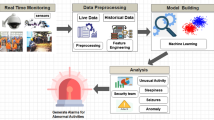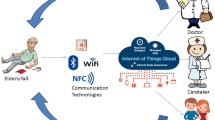Abstract
Human identification on construction sites is critical for minimizing safety mishaps. Existing approaches have shortcomings such as a low recognition rate, workplace locating errors, and alarming latency. These challenges are addressed in this study by developing a Fog Cloud Computing, Internet of Things (IoT)-based Human Identification system based on Gait Sequences. Gait recognition, as a prospective biometric identification approach, has several advantages, including the ability to identify humans at a great distance, without any interaction, and the difficulty of imitating. However, due to the complexity of the external components involved in the collection and sampling of gait data and changes in the clothing style of an individual to be recognized, this recognition technology continues to confront several obstacles in real-time applications. In this study, the purpose is to offer a unique method for gait feature extraction and classification at construction sites. The feature vectors derived from Speeded Up Robust Features (SURF) and Convolutional Neural Networks (CNN) are integrated. The classification is performed by applying a Support Vector Machine (SVM) to increase the recognition rate at the Fog layer. The decision-making, record storage, and monitoring processing are performed in the cloud layer. On comparative analysis, experimental results demonstrate that our proposed model outperforms the existing methods and attained the highest accuracy of 97.19%.









Similar content being viewed by others
Data availability
The datasets used and analyzed during the current study are available from the corresponding author on reasonable request.
References
Ani Brown Mary N, Dharma D (2018) Coral reef image/video classification employing novel octa-angled pattern for triangular sub region and pulse coupled convolutional neural network (PCCNN). Multimed Tools Appl 77:31545–31579
Anshu AK, Arya KV, Gupta A (2020) View invariant gait feature extraction using temporal pyramid pooling with 3D convolutional neural network. In: IEEE 15th international conference on industrial and information systems (ICIIS). https://doi.org/10.1109/ICIIS51140.2020.9342689
Arroyo R, Yebes JJ, Bergasa LM, Daza I, Almazán J (2015) Expert video-surveillance system for real-time detection of suspicious behaviors in shopping malls. Expert Syst Appl 42(21):7991–8005
Batool S, Hassan A, Saqib NA, Khattak MAK (2020) Authentication of remote IoT users based on deeper gait analysis of sensor data. IEEE Access 8:101784–101796
Bay H, Ess A, Tuytelaars T, Gool LV (2008) Speeded-up robust features (SURF). Comput Vis Image Underst 110(3):346–359
Boulgouris NV, Huang X (2013) Gait recognition using HMMs and dual discriminative observations for sub-dynamics analysis. IEEE Transections 22(9):3636–3647. https://doi.org/10.1109/TIP.2013.2266578
Chien J, Wu C (Dec. 2002) Discriminant waveletfaces and nearest feature classifiers for face recognition. IEEE Trans Pattern Anal Mach Intell 24(12):1644–1649
Cohen A, Colligan M, Sinclair R, Newman J, Schuler R (1998) Assessing occupational safety and health training a literature review. National Institute for Occupational Safety and Health
Davis J, Kulis B, Jain P, Sra S, Dhillon I (2007) Information theoretic metric learning. In: 24th international conference on machine learning
Elharrouss O, Almaadeed N, Al-Maadeed S, Bouridane A (2020) Gait recognition for person re-identification. J Supercomput 77:1–20
Fardhosseini MS, Habibnezhad M, Jebelli H, Migliaccio G, Lee HW, Puckett J (2020) Recognition of Construction Workers’ Physical Fatigue Based on Gait Patterns Driven from Three-axis Accelerometer Embedded in a Smartphone. In: Construction Research Congress, TEMPE, ARIZONA
“Fatal occupational injuries counts and rates for selected occupations,” U.S. Bureau of Labor Statistics, 2017
Gacsadi I, Buciu A (2016) Biometrics systems and technologies: a survey. Int J Comput Commun Control 11(3):315–330
Goldberger J, Roweis S, Hinton G, Salakhutdinov R (2004) Neighborhood Component Analysis. Advances in Neural Information Processing Systems. Cambridge, MA,USA:MIT Press, p. 2539–2544
Gupta S, Thakur K, Kumar M (2020) 2D-human face recognition using SIFT and SURF descriptors of face’s feature regions. Vis Comput Int J Comput Graph 37:447–456
Han J, Bhanu B (2006) Individual recognition using gait energy image. IEEE Transections 28(02):316–323
Hussain M, Bird JJ, Faria DR (2019) A study on CNN transfer learning for image classification. Adv Comput Intell Syst 840:191–202
Jannadi OA, Bu-Khamsin MS (2002) Safety factors considered by industrial contractors in Saudi Arabia. Build Environ 37:539–547
Jayanthia N, Raja D, Wadhwa G, Shneka K, Swathi R (2021) IoT based-civil labour safety monitoring system in construction site. Turk J Comput Math Educ 12(9):1723–1728
Jayapriya K, Jacob IJ, Mary NAB (2020) Person re-identification using prioritized chromatic texture (PCT) with deep learning. Multimed Tools Appl 79(4):29399–29410
Jina R, Zhangb H, Liua D, Yanb X (2020) IoT-based detecting, locating and alarming of unauthorized intrusion on construction sites. Autom Constr 118:103278
Khamsemanan N, Nattee C, Jianwattanapaisarn N (2017) Human identification from freestyle walks using posture-based gait feature. IEEE Trans Inf Forensics Secur 13(1):119–128
Kim CS, Nandyala HK (2016) From cloud to fog and IoT-based real-time U-healthcare monitoring for smart homes and hospitals. Int J Smart Home 10(2):187–196
Labati RD, Genovese A, Muñoz E, Piuri V, Scotti F, Sforza G (2016) Biometric recognition in automated border control: a survey. ACM Comput Surv (CSUR) 49(2):1–39
Langford D, Rowlinson S, Sawacha E (2002) Safety behaviour and safety management: its influence on the attitudes of workers in the UK construction industry. Eng Constr Archit Manag 7:133–140
Li H, Dong S, Martin S, He Q, Yin Q (2016) Intrusion warning and assessment method for site safety enhancement. Saf Sci 84:97–107
Liu T, Ye X, Sun B (2018) Combining Convolutional Neural Network and Support Vector Machine for Gait-based Gender Recognition. In: IEEE, Xi'an, China
Lu J, Wang G, Moulin P (2014) Human identity and gender recognition from gait sequences with arbitrary walking directions. IEEE Trans Inf Forensics Secur 9(1):51–61
McCann M, Hunting K, Murawski J, Chowdhury R, Welch L (2003) Causes of electrical deaths and injuries among construction workers. Am J Ind Med 43(4):398–406
Neural Networks For Non-Intrusive Biometric Recognition, (n.d.) http://www.advancedsourcecode.com/gaitrecognition.asp. Accessed 4 June 2020
Ng H, Tong HL, Tan WH, Abdullah J (2011) Gait classification by support vector machine. Commun Comput Inf Sci:623–636
Pedersen JT (2011) Study group SURF: Feature detection & description. In” Department of Computer Science, Aarhus University
Pradhan N, Singh AS (2020) Machine learning architecture and framework. Machine Learning and Cognitive Computing for Mobile Communications and Wireless Networks, pp. 1–24
Rida I, Almaadeed N, Almaadeed S (2018) Robust gait recognition: a comprehensive survey. IET Biometrics 8(1):14–28
Saleem F, Khan MA, Alhaisoni M, Tariq U, Armghan A, Alenezi F, Choi JI, Kadry S (2021) Human gait recognition: a single stream optimal deep learning features fusion. Sensors 21(22):1–23
Seifert A, Amin MG, Zoubir AM (2019) Toward unobtrusive in-home gait analysis based on radar micro-Doppler signatures. IEEE Trans Biomed Eng 66(9):2629–2640
Shapira A, ASCE F, Simcha M, Goldenberg M (2012) Integrative model for quantitative evaluation of safety on construction sites with tower cranes. J Constr Eng Manag 138(11):1281–1293
Sharma S, Lone FR, Lone MR (2020) Machine Learning for Enhancement of Security in Internet of Things Based Applications. Security and Privacy in the Internet of Things, p. 95
Son H, Choi H, Seong H, Kim C (2019) Detection of construction workers under varying poses and changing background in image sequences via very deep residual networks. Autom Constr 99:27–38
Tetsu M, Einoshin S (2016) Person Re-Identification Using CNN Features Learned from Combination of Attributes. In: 23rd International Conference on Pattern Recognition (ICPR), Cancún; Mexico
Törner M, Pousette A (2009) Safety in construction-a comprehensive description of the characteristics of high safety standards in construction work, from the combined perspective of supervisors and experienced workers. J Saf Res 40(6):399–409
Umeokafor N, Evaggelinos K, Lundy DIS, Allan S, Igwegbe O, Umeadi B (2014) The pattern of occupational accidents, injuries, accident causal factors and intervention in Nigerian factories. Dev Country Stud 5(15):119–127
“Underlying causes of construction fatal accidents-review and sample analysis of recent construction fatal accidents,” Health and Safety Executive Construction Division, (2009)
Weinberger K, Blitzer J, Saul L (2005) Distance metric learning for large margin nearest neighbor classification. Advances in Neural Information Processing Systems. Cambridge, MA, USA: MIT Press, p. 1473–1480
Zhou Z, Li Q, Wu W (2012) Developing a versatile subway construction incident database for safety management. J Constr Eng Manag 138:1169–1180
Author information
Authors and Affiliations
Corresponding author
Ethics declarations
Conflict of interests
The authors declare that they have no conflict of interest.
Additional information
Publisher’s note
Springer Nature remains neutral with regard to jurisdictional claims in published maps and institutional affiliations.
Rights and permissions
Springer Nature or its licensor holds exclusive rights to this article under a publishing agreement with the author(s) or other rightsholder(s); author self-archiving of the accepted manuscript version of this article is solely governed by the terms of such publishing agreement and applicable law.
About this article
Cite this article
Ahmed, K., Saini, M. Fog cloud-assisted IoT-based human identification in construction sites from gait sequences. Multimed Tools Appl 82, 14265–14285 (2023). https://doi.org/10.1007/s11042-022-13785-0
Received:
Revised:
Accepted:
Published:
Issue Date:
DOI: https://doi.org/10.1007/s11042-022-13785-0




